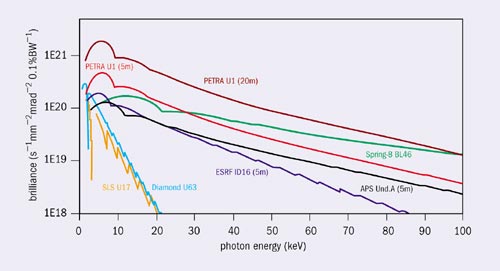
DESY is to convert its storage ring PETRA into one of the most modern third-generation X-ray sources in the world. “PETRA III” is expected to provide the highest brilliance of any storage ring-based X-ray source until the first linac-driven sources begin operating.
At present, more than 2000 physicists, chemists, biologists, geologists, and researchers working in the fields of materials science or life sciences, use the facilities at DESY’s Hamburg Synchrotron Radiation Laboratory, HASYLAB, for experiments with soft and hard X-ray radiation in basic and applied research. As a second-generation synchrotron radiation source, however, DESY’s current “workhorse”, DORIS III, is not comparable in terms of brilliance with modern third-generation hard X-ray sources such as the ESRF in Grenoble, APS in Argonne or Spring-8 in Japan. In order to remain competitive in the synchrotron radiation sector, DESY has therefore decided to convert PETRA as soon as the HERA physics programme is completed, from 2007 onwards.

PETRA was successfully used for particle physics from 1978 to 1986, and since then, as PETRA II, it has been part of the injector chain for DESY’s HERA collider. In addition, it also supplies intense X-ray light from one undulator to three experimental test stations. The upgrade of PETRA will require the total rebuilding of one-eighth of the storage ring to provide the electron-beam optics for nine straight sections, each of which will offer space for one 5 m long or two 2 m long insertion devices – “wiggler” and “undulator” magnets in which synchrotron radiation of high brilliance will be generated. Depending on the exact outline of the beamlines, about 13 experimental stations with independently tunable insertion devices will become available.
A positron energy of 6 GeV is currently predicted, with a beam current of at least 100 mA. This means that the energy of the synchrotron radiation photons will reach up to more than 100 keV. The installation of a number of damping wigglers, with a total length of 100 m in the empty long straight sections of the storage ring, will allow the upgraded facility to provide an emittance as small as 1 nm rad. Such a small emittance is essential for the generation of highly brilliant high-energy photons in arrangements of undulator magnets. Compared with a number of other synchrotron radiation storage rings, an upgraded PETRA storage ring with damping wigglers offers the best basis for a low-emittance, high-brilliance synchrotron radiation source at higher particle energies. Only the “Ultimate Storage Ring” study carried out by the ESRF machine group, which describes an ideal storage ring-based light source and energy recovery linac-driven sources at high particle energies will be able to provide smaller emittances.
To ensure reliable machine operation and a beam lifetime limited only by intrinsic positron beam parameters, PETRA’s existing vacuum system and a large portion of the infrastructure have to be replaced, and planning for a detailed layout of the new experimental hall is currently underway. The German federal government approved the PETRA upgrade project in February 2003 and agreed to finance it with €120 million. A formal proposal for the upgrade will be completed by the end of 2003, after the input of a series of workshops with potential users, so that reconstruction can begin as planned in January 2007.





